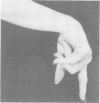Abstract
Movement disorders are usually of central origin, but sometimes involuntary movements occur after peripheral trauma. Twenty eight patients, 13 women and 15 men, mean age 37 years (range 15-78), were studied with dystonia or tremor in whom the onset of abnormal movements was related, in time and in distribution, to injury of a body part. Among 23 patients with latency of less than one year after injury, focal dystonia of the involved body part was found in 18, nine of whom had associated reflex sympathetic dystrophy (RSD). One of five patients with peripherally induced tremor had RSD. Abnormal electromyography or nerve conduction velocities were found in the affected limb in four patients, but other electrophysiologic techniques provided evidence for disturbed central function. In 15 patients (65%) possible predisposing factors may have contributed to the pathogenesis of the trauma induced abnormal involuntary movements.
Full text
PDF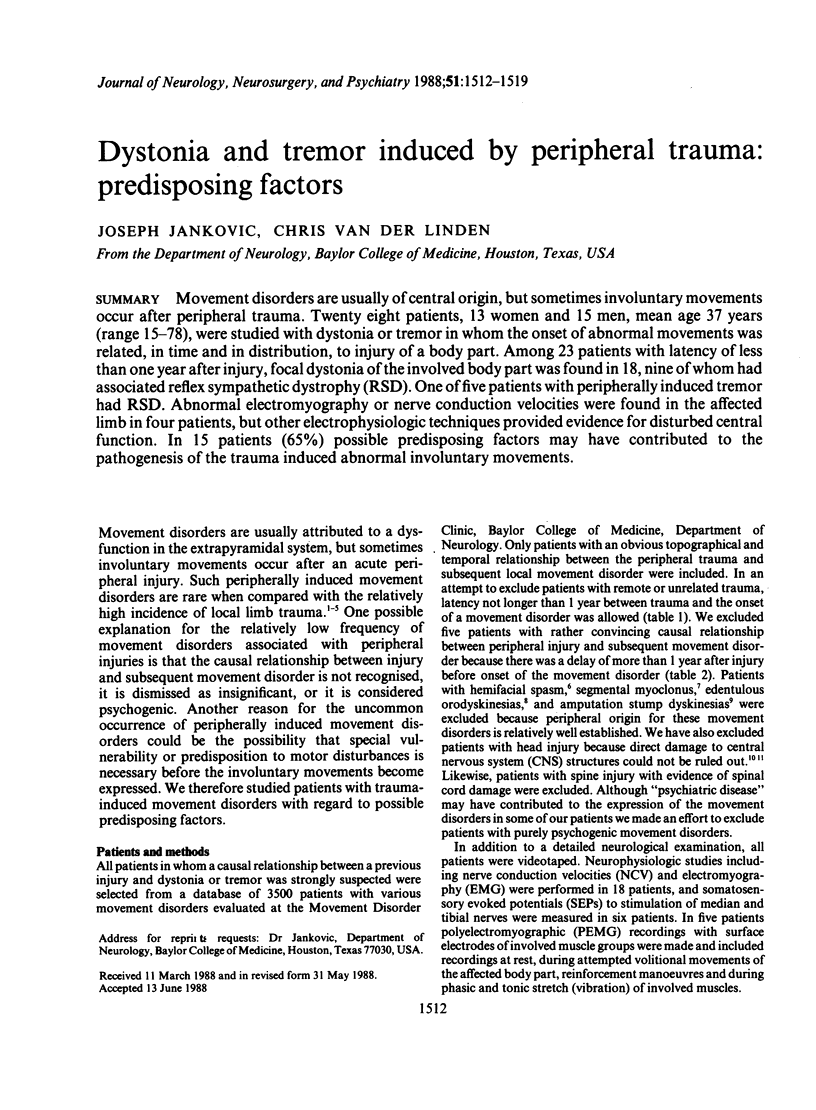
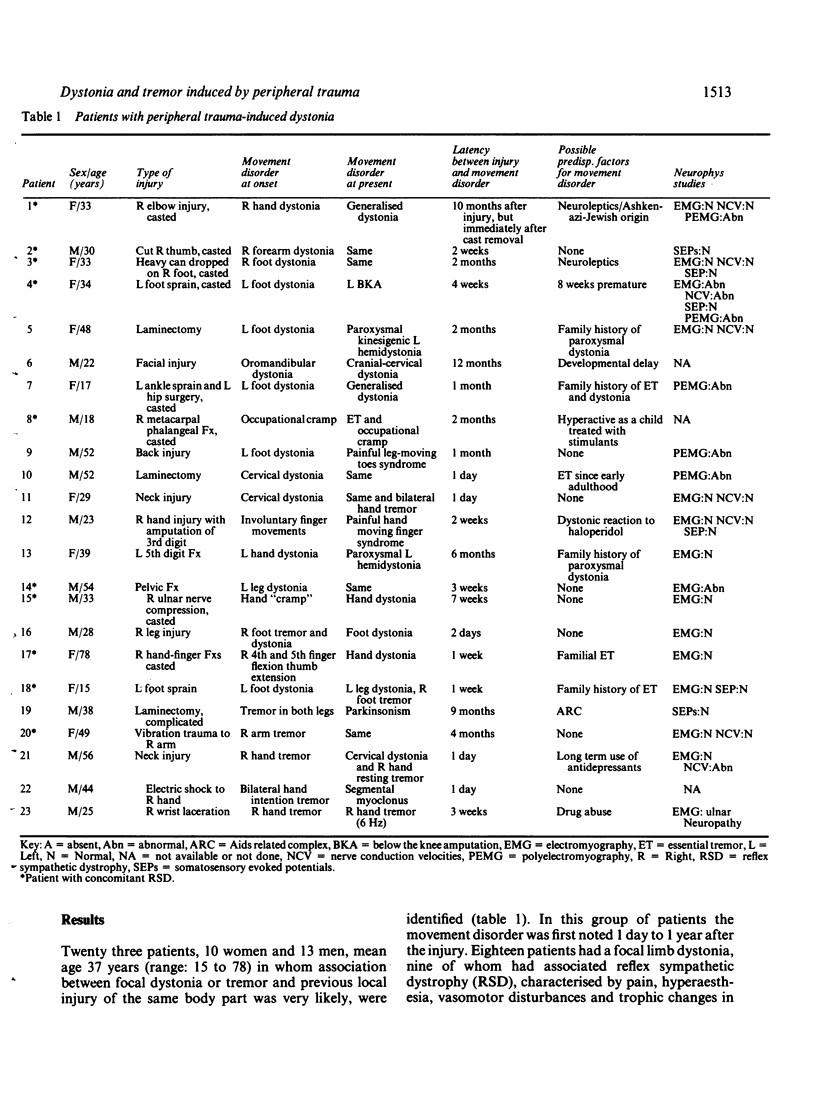
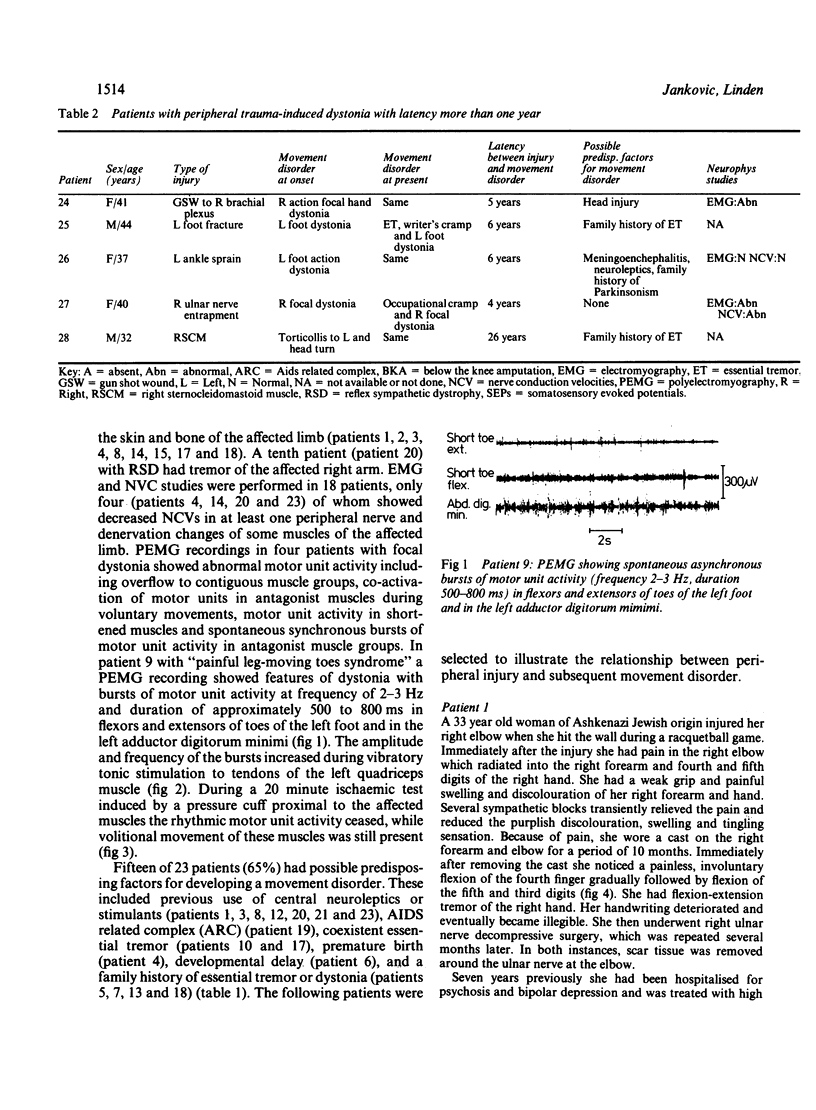
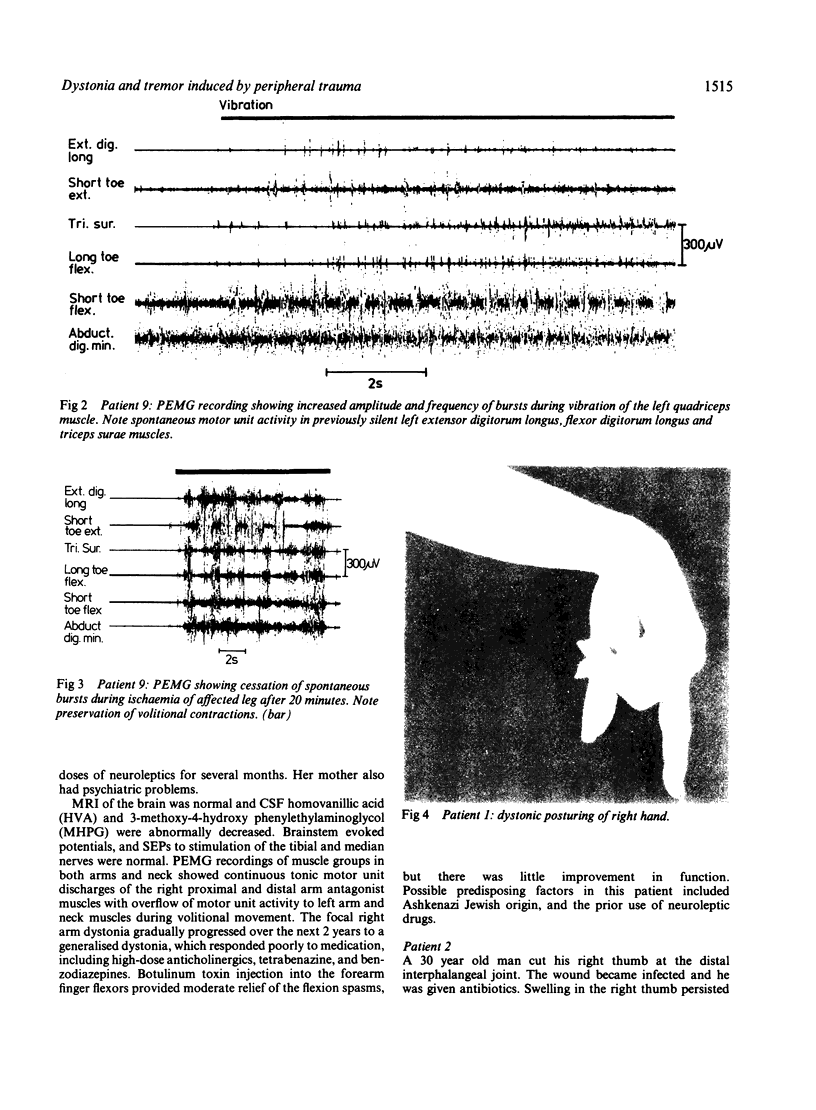
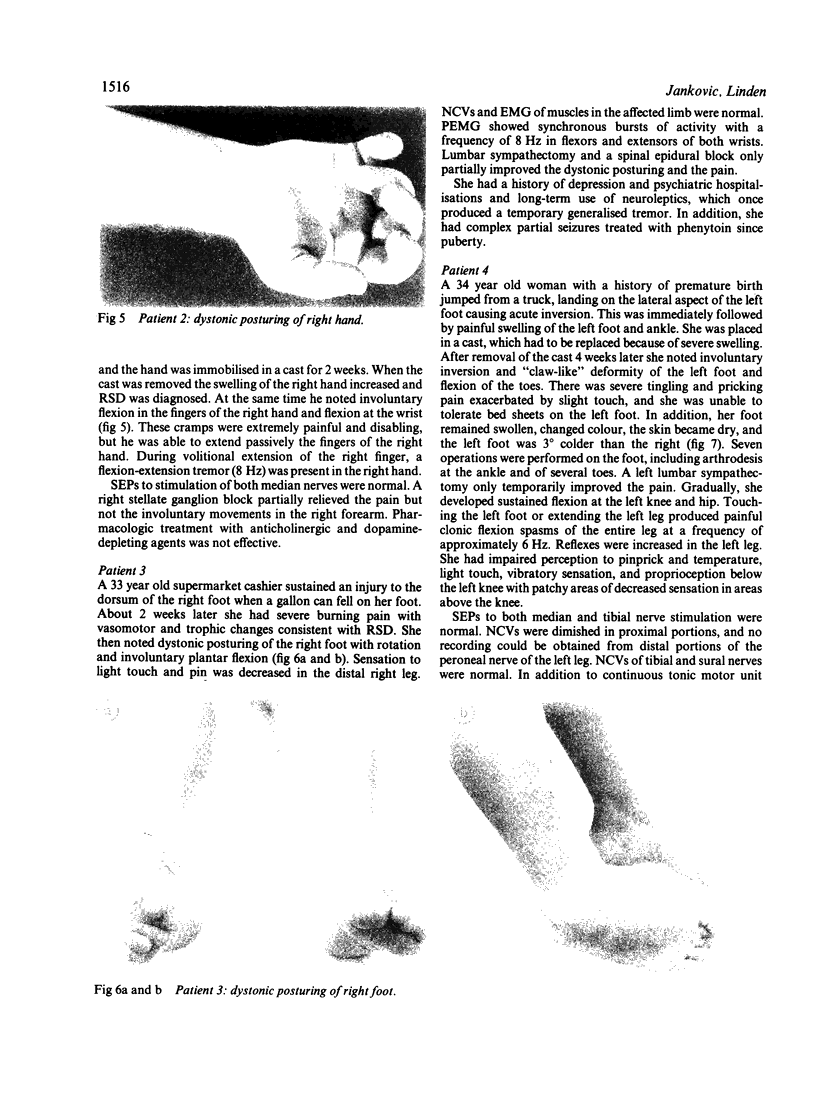
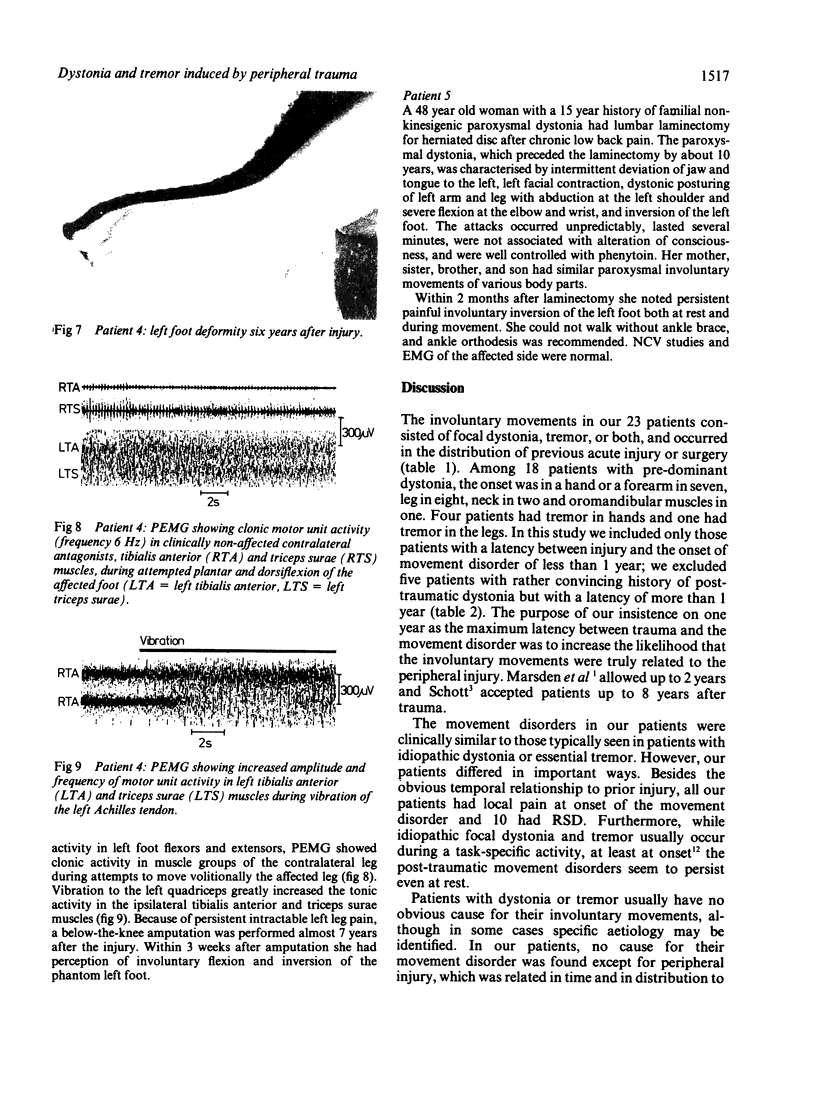
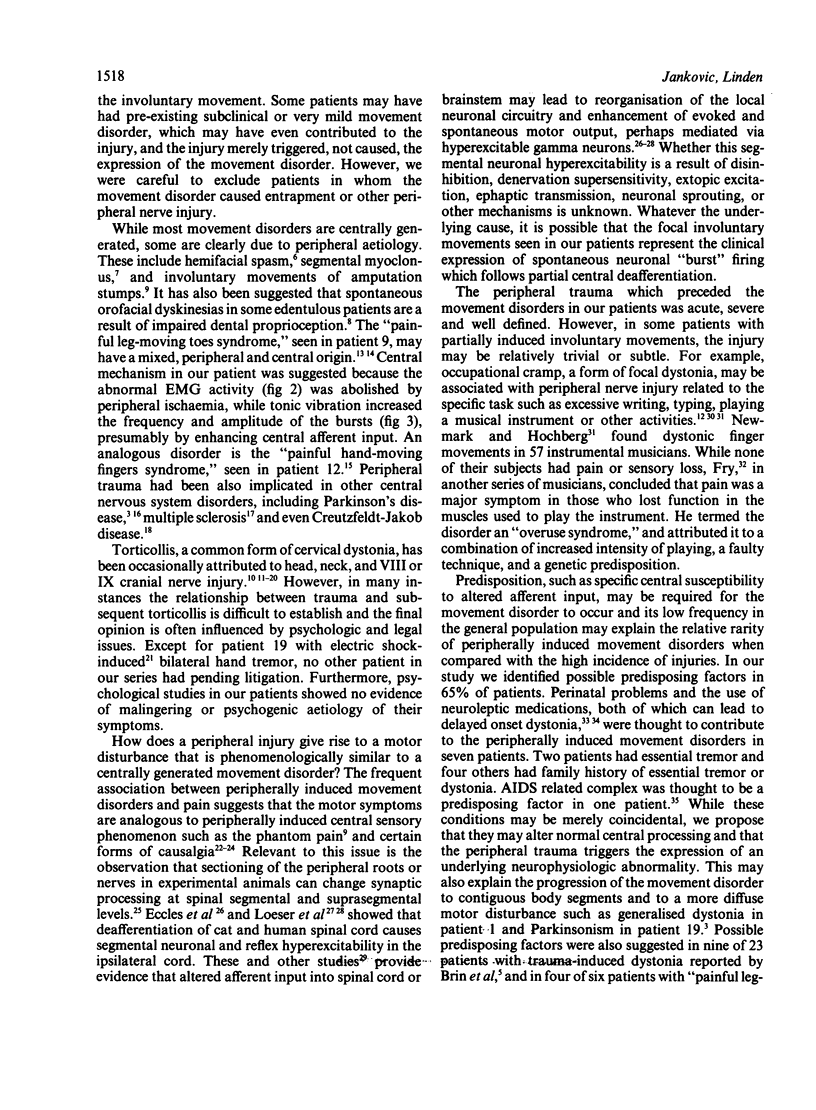

Images in this article
Selected References
These references are in PubMed. This may not be the complete list of references from this article.
- Bronstein A. M., Rudge P., Beechey A. H. Spasmodic torticollis following unilateral VIII nerve lesions: neck EMG modulation in response to vestibular stimuli. J Neurol Neurosurg Psychiatry. 1987 May;50(5):580–586. doi: 10.1136/jnnp.50.5.580. [DOI] [PMC free article] [PubMed] [Google Scholar]
- Burke R. E., Fahn S., Gold A. P. Delayed-onset dystonia in patients with "static" encephalopathy. J Neurol Neurosurg Psychiatry. 1980 Sep;43(9):789–797. doi: 10.1136/jnnp.43.9.789. [DOI] [PMC free article] [PubMed] [Google Scholar]
- Digre K., Corbett J. J. Hemifacial spasm: differential diagnosis, mechanism, and treatment. Adv Neurol. 1988;49:151–176. [PubMed] [Google Scholar]
- Drake M. E., Jr Spasmodic torticollis after closed head injury. J Natl Med Assoc. 1987 May;79(5):561–563. [PMC free article] [PubMed] [Google Scholar]
- Farrell D. F., Starr A. Delayed neurological sequelae of electrical injuries. Neurology. 1968 Jun;18(6):601–606. doi: 10.1212/wnl.18.6.601. [DOI] [PubMed] [Google Scholar]
- Fry H. J. Overuse syndrome in musicians: prevention and management. Lancet. 1986 Sep 27;2(8509):728–731. doi: 10.1016/s0140-6736(86)90242-4. [DOI] [PubMed] [Google Scholar]
- Hochberg F. H., Leffert R. D., Heller M. D., Merriman L. Hand difficulties among musicians. JAMA. 1983 Apr 8;249(14):1869–1872. doi: 10.1001/jama.249.14.1869. [DOI] [PubMed] [Google Scholar]
- Jankovic J., Glass J. P. Metoclopramide-induced phantom dyskinesia. Neurology. 1985 Mar;35(3):432–435. doi: 10.1212/wnl.35.3.432. [DOI] [PubMed] [Google Scholar]
- Jankovic J., Orman J. Botulinum A toxin for cranial-cervical dystonia: a double-blind, placebo-controlled study. Neurology. 1987 Apr;37(4):616–623. doi: 10.1212/wnl.37.4.616. [DOI] [PubMed] [Google Scholar]
- Jankovic J., Pardo R. Segmental myoclonus. Clinical and pharmacologic study. Arch Neurol. 1986 Oct;43(10):1025–1031. doi: 10.1001/archneur.1986.00520100039012. [DOI] [PubMed] [Google Scholar]
- Kaas J. H., Merzenich M. M., Killackey H. P. The reorganization of somatosensory cortex following peripheral nerve damage in adult and developing mammals. Annu Rev Neurosci. 1983;6:325–356. doi: 10.1146/annurev.ne.06.030183.001545. [DOI] [PubMed] [Google Scholar]
- Koller W. C. Edentulous orodyskinesia. Ann Neurol. 1983 Jan;13(1):97–99. doi: 10.1002/ana.410130121. [DOI] [PubMed] [Google Scholar]
- Kondo K., Kuroiwa Y. A case control study of Creutzfeldt-Jakob disease: association with physical injuries. Ann Neurol. 1982 Apr;11(4):377–381. doi: 10.1002/ana.410110410. [DOI] [PubMed] [Google Scholar]
- Loeser J. D., Ward A. A., Jr Some effects of deafferentation on neurons of the cat spinal cord. Arch Neurol. 1967 Dec;17(6):629–636. doi: 10.1001/archneur.1967.00470300071012. [DOI] [PubMed] [Google Scholar]
- Loeser J. D., Ward A. A., Jr, White L. E., Jr Chronic deafferentation of human spinal cord neurons. J Neurosurg. 1968 Jul;29(1):48–50. doi: 10.3171/jns.1968.29.1.0048. [DOI] [PubMed] [Google Scholar]
- MILLER H. TRAUMA AND MULTIPLE SCLEROSIS. Lancet. 1964 Apr 18;1(7338):848–850. doi: 10.1016/s0140-6736(64)91576-4. [DOI] [PubMed] [Google Scholar]
- Marsden C. D., Obeso J. A., Traub M. M., Rothwell J. C., Kranz H., La Cruz F. Muscle spasms associated with Sudeck's atrophy after injury. Br Med J (Clin Res Ed) 1984 Jan 21;288(6412):173–176. doi: 10.1136/bmj.288.6412.173. [DOI] [PMC free article] [PubMed] [Google Scholar]
- Mortimer J. A., Pirozzolo F. J., Hansch E. C., Webster D. D. Relationship of motor symptoms to intellectual deficits in Parkinson disease. Neurology. 1982 Feb;32(2):133–137. doi: 10.1212/wnl.32.2.133. [DOI] [PubMed] [Google Scholar]
- Nath A., Jankovic J., Pettigrew L. C. Movement disorders and AIDS. Neurology. 1987 Jan;37(1):37–41. doi: 10.1212/wnl.37.1.37. [DOI] [PubMed] [Google Scholar]
- Newmark J., Hochberg F. H. Isolated painless manual incoordination in 57 musicians. J Neurol Neurosurg Psychiatry. 1987 Mar;50(3):291–295. doi: 10.1136/jnnp.50.3.291. [DOI] [PMC free article] [PubMed] [Google Scholar]
- Rosenbaum F., Jankovic J. Focal task-specific tremor and dystonia: categorization of occupational movement disorders. Neurology. 1988 Apr;38(4):522–527. doi: 10.1212/wnl.38.4.522. [DOI] [PubMed] [Google Scholar]
- Scherokman B., Husain F., Cuetter A., Jabbari B., Maniglia E. Peripheral dystonia. Arch Neurol. 1986 Aug;43(8):830–832. doi: 10.1001/archneur.1986.00520080068025. [DOI] [PubMed] [Google Scholar]
- Schott G. D. "Painful legs and moving toes": the role of trauma. J Neurol Neurosurg Psychiatry. 1981 Apr;44(4):344–346. doi: 10.1136/jnnp.44.4.344. [DOI] [PMC free article] [PubMed] [Google Scholar]
- Schott G. D. Induction of involuntary movements by peripheral trauma: an analogy with causalgia. Lancet. 1986 Sep 27;2(8509):712–716. doi: 10.1016/s0140-6736(86)90231-x. [DOI] [PubMed] [Google Scholar]
- Schott G. D. Mechanisms of causalgia and related clinical conditions. The role of the central and of the sympathetic nervous systems. Brain. 1986 Aug;109(Pt 4):717–738. doi: 10.1093/brain/109.4.717. [DOI] [PubMed] [Google Scholar]
- Schott G. D. The relationship of peripheral trauma and pain to dystonia. J Neurol Neurosurg Psychiatry. 1985 Jul;48(7):698–701. doi: 10.1136/jnnp.48.7.698. [DOI] [PMC free article] [PubMed] [Google Scholar]
- Schwartzman R. J., McLellan T. L. Reflex sympathetic dystrophy. A review. Arch Neurol. 1987 May;44(5):555–561. doi: 10.1001/archneur.1987.00520170081028. [DOI] [PubMed] [Google Scholar]
- Sheehy M. P., Marsden C. D. Trauma and pain in spasmodic torticollis. Lancet. 1980 Apr 5;1(8171):777–778. doi: 10.1016/s0140-6736(80)91281-7. [DOI] [PubMed] [Google Scholar]
- Shima F., Fukui M., Matsubara T., Kitamura K. Spasmodic torticollis caused by vascular compression of the spinal accessory root. Surg Neurol. 1986 Nov;26(5):431–434. doi: 10.1016/0090-3019(86)90254-5. [DOI] [PubMed] [Google Scholar]
- Verhagen W. I., Horstink M. W., Notermans S. L. Painful arm and moving fingers. J Neurol Neurosurg Psychiatry. 1985 Apr;48(4):384–385. doi: 10.1136/jnnp.48.4.384. [DOI] [PMC free article] [PubMed] [Google Scholar]
- Ward C. D., Duvoisin R. C., Ince S. E., Nutt J. D., Eldridge R., Calne D. B. Parkinson's disease in 65 pairs of twins and in a set of quadruplets. Neurology. 1983 Jul;33(7):815–824. doi: 10.1212/wnl.33.7.815. [DOI] [PubMed] [Google Scholar]



